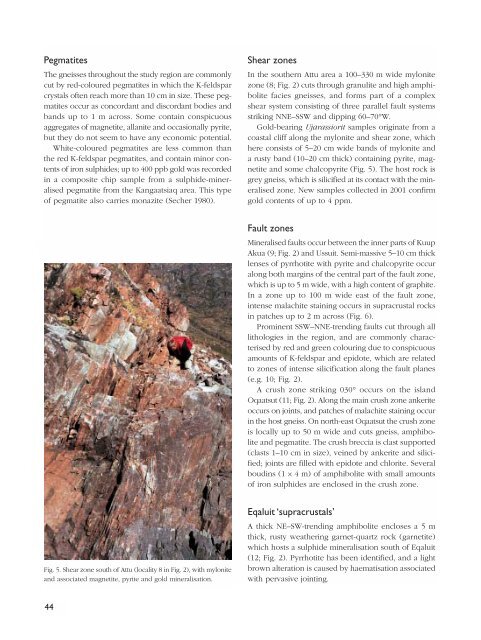Review of Greenland Avtivities 2001 - Geus
Review of Greenland Avtivities 2001 - Geus
Review of Greenland Avtivities 2001 - Geus
You also want an ePaper? Increase the reach of your titles
YUMPU automatically turns print PDFs into web optimized ePapers that Google loves.
Pegmatites<br />
The gneisses throughout the study region are commonly<br />
cut by red-coloured pegmatites in which the K-feldspar<br />
crystals <strong>of</strong>ten reach more than 10 cm in size. These pegmatites<br />
occur as concordant and discordant bodies and<br />
bands up to 1 m across. Some contain conspicuous<br />
aggregates <strong>of</strong> magnetite, allanite and occasionally pyrite,<br />
but they do not seem to have any economic potential.<br />
White-coloured pegmatites are less common than<br />
the red K-feldspar pegmatites, and contain minor contents<br />
<strong>of</strong> iron sulphides; up to 400 ppb gold was recorded<br />
in a composite chip sample from a sulphide-mineralised<br />
pegmatite from the Kangaatsiaq area. This type<br />
<strong>of</strong> pegmatite also carries monazite (Secher 1980).<br />
Shear zones<br />
In the southern Attu area a 100–330 m wide mylonite<br />
zone (8; Fig. 2) cuts through granulite and high amphibolite<br />
facies gneisses, and forms part <strong>of</strong> a complex<br />
shear system consisting <strong>of</strong> three parallel fault systems<br />
striking NNE–SSW and dipping 60–70°W.<br />
Gold-bearing Ujarassiorit samples originate from a<br />
coastal cliff along the mylonite and shear zone, which<br />
here consists <strong>of</strong> 5–20 cm wide bands <strong>of</strong> mylonite and<br />
a rusty band (10–20 cm thick) containing pyrite, magnetite<br />
and some chalcopyrite (Fig. 5). The host rock is<br />
grey gneiss, which is silicified at its contact with the mineralised<br />
zone. New samples collected in <strong>2001</strong> confirm<br />
gold contents <strong>of</strong> up to 4 ppm.<br />
Fault zones<br />
Mineralised faults occur between the inner parts <strong>of</strong> Kuup<br />
Akua (9; Fig. 2) and Ussuit. Semi-massive 5–10 cm thick<br />
lenses <strong>of</strong> pyrrhotite with pyrite and chalcopyrite occur<br />
along both margins <strong>of</strong> the central part <strong>of</strong> the fault zone,<br />
which is up to 5 m wide, with a high content <strong>of</strong> graphite.<br />
In a zone up to 100 m wide east <strong>of</strong> the fault zone,<br />
intense malachite staining occurs in supracrustal rocks<br />
in patches up to 2 m across (Fig. 6).<br />
Prominent SSW–NNE-trending faults cut through all<br />
lithologies in the region, and are commonly characterised<br />
by red and green colouring due to conspicuous<br />
amounts <strong>of</strong> K-feldspar and epidote, which are related<br />
to zones <strong>of</strong> intense silicification along the fault planes<br />
(e.g. 10; Fig. 2).<br />
A crush zone striking 030° occurs on the island<br />
Oqaatsut (11; Fig. 2). Along the main crush zone ankerite<br />
occurs on joints, and patches <strong>of</strong> malachite staining occur<br />
in the host gneiss. On north-east Oqaatsut the crush zone<br />
is locally up to 50 m wide and cuts gneiss, amphibolite<br />
and pegmatite. The crush breccia is clast supported<br />
(clasts 1–10 cm in size), veined by ankerite and silicified;<br />
joints are filled with epidote and chlorite. Several<br />
boudins (1 x 4 m) <strong>of</strong> amphibolite with small amounts<br />
<strong>of</strong> iron sulphides are enclosed in the crush zone.<br />
Fig. 5. Shear zone south <strong>of</strong> Attu (locality 8 in Fig. 2), with mylonite<br />
and associated magnetite, pyrite and gold mineralisation.<br />
Eqaluit ‘supracrustals’<br />
A thick NE–SW-trending amphibolite encloses a 5 m<br />
thick, rusty weathering garnet-quartz rock (garnetite)<br />
which hosts a sulphide mineralisation south <strong>of</strong> Eqaluit<br />
(12; Fig. 2). Pyrrhotite has been identified, and a light<br />
brown alteration is caused by haematisation associated<br />
with pervasive jointing.<br />
44

















